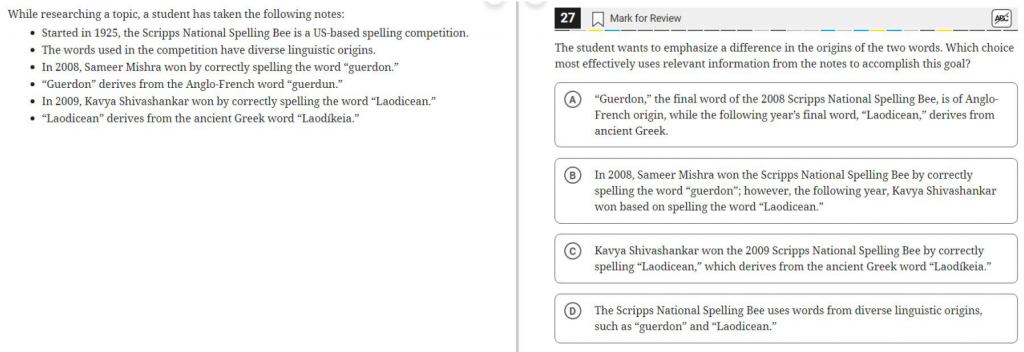Top 4 Time-Saving Tips for the Digital SAT
By Michael Freeman

Table of Contents
Recent changes to the SAT — now officially renamed the Digital SAT — have high school students all over the world breathing a massive sigh of relief. The new test is roughly an hour shorter, administered on a computer, and replaces the notoriously long Reading and Writing section with a series of much shorter texts.
Because of these changes, many students assume that time management is no longer paramount; unfortunately, this assumption is also the downfall of many first-time test takers.
With only 32 minutes to complete a module consisting of 27 questions, effective time management is crucial. Students who don’t prioritize it will be at a significant disadvantage, as they’ll have less time to tackle challenging questions. This can result in not having enough time to answer questions they could have answered correctly if given the chance.
If you’re a student planning to take the SAT soon, here are four tips that will help you avoid the most common pitfalls on test day — when every second really does count.
1. Ignore the Notes in Rhetorical Synthesis Questions
One of the most noticeable changes to the SAT is the addition of so-called “rhetorical synthesis” questions. These questions present test takers with a simple hypothetical scenario: a student is researching a topic and has taken some notes. The corresponding question then informs test takers that the student wants to accomplish a particular goal or goals. As seen below, it is the test taker’s job to identify which answer choice “most effectively uses relevant information from the notes to accomplish this goal.”

The language of this question too often leads test takers to think they must read through all the notes. And because there are often several bullet points to read through, students taking the test may spend up to a minute reading all of the notes.
Much to the surprise of many prospective test takers, however, this isn’t necessary in order to answer the question correctly.
Instead, students should begin by skipping the notes completely and simply identifying the student’s goal or goals in the question. Then, they should immediately head to the answer choices seeking one that accomplishes all stated goals.
In the example above, only answer choice A emphasizes the differences in the origins of the respective words; a student should therefore feel confident in selecting it as the right answer even if they have not looked at the notes.
Because there are usually two or three rhetorical synthesis questions in a given module, skipping the long list of notes can save huge chunks of time and allow students to focus only on what matters most.
2. Abbreviate Unfamiliar Names and Terms
The Digital SAT’s revamped Reading and Writing section includes a greater number of challenging, hard-to-pronounce words scattered across many individual passages. This influx of proper nouns adds a new layer of complexity, demanding sharper focus and stronger vocabulary skills.
Expect Unfamiliar Terms
Students should anticipate encountering a variety of unfamiliar proper nouns, noun phrases, and obscure jargon in nearly every question. This includes:
- Names of People Groups: (e.g., Haudenosaunee)
- Names of Things: (e.g., mycorrhizal fungi)
- Personal Names of Scientists: (e.g., Adebayo Oluwole Eludoyin)
- Binomial Nomenclature: (e.g., Astyanax mexicanus)
These examples represent just a small fraction of the names found on official practice tests.
Cultural and Academic Diversity
The inclusion of different names provides exposure to a variety of cultures and academic fields. However, students often waste valuable time attempting to pronounce these names correctly, which is unnecessary since there is no penalty for mispronunciation.
Abbreviation Strategy
To save time, students should abbreviate unfamiliar names quickly. The chosen abbreviation should be easy to remember throughout the question and answer process. For example:
- “mycorrhizal fungi” can be shortened to “m. fungi”
- “Fritz Schlunegger” can be abbreviated as “FS”
Time-Saving Benefits
By effectively abbreviating names, students can save precious seconds on each question. This can add up to 1-2 minutes saved over the course of both modules, allowing more time and energy to focus on solving the questions themselves.
3. Work Backwards on the Challenge Module
The Digital SAT is now an adaptive test, so students who perform particularly well on the first module of the Reading and Writing section can expect to encounter a “challenge” module in the latter half of the section.
As its name suggests, this module contains questions that are generally much more difficult. Even students who have scored above 700 on practice tests may find themselves pressed for time compared to the first module.
However, there are questions that students usually consider easier to master and quicker to solve, such as those testing knowledge of standard conventions, use of transitions, and rhetorical synthesis. Importantly, these questions are included only in the back half of the module.
Together, these aspects of the test mean that students who complete the challenge module in the conventional way—by starting with Question 1—are engaging in two inherently risky behaviors:
- Spending Excessive Time on Difficult Questions Up Front: Students who begin with Question 1 may spend more time on questions that are harder to answer correctly. These questions typically have longer and more complex stimuli, increasing the likelihood of burnout before reaching the easier questions.
- Rushing Through Easier Questions: As a consequence of spending too much time on the difficult questions, students often rush through the easier questions in the latter half of the module. This haste can lead to mistakes and missed opportunities to score points on questions they would otherwise answer correctly.
One effective solution to mitigate these risks is slightly unconventional but quite simple: start at the end of the challenge module (Question 27) and work backward.
While this strategy isn’t essential for achieving a high score, it can be particularly beneficial for students who struggle to finish within the time limits. This approach is especially valuable for students whose native language is not English, as they may find the vocabulary-in-context questions (often at the beginning of the module) the most challenging.
Students who have already taken one practice test should consider trying this strategy on their next mock exam and compare the results.
4. Flag the Most Difficult Questions and Revisit Them Later
Another way students can optimize their time on exam day is by utilizing the new digital tools available through the Bluebook exam application. These tools include features like a countdown clock and the ability to highlight text, but the most valuable tool is arguably the option to flag questions for review.
Students who find themselves spending more than 90 seconds on a question—or two minutes on a more complex inference question—should consider flagging the question and returning to it later if time allows.
Flagging a question takes only a second and should generally be used sparingly, perhaps two or three times during the challenge module. The primary advantage of this technique is avoiding time sinks, enabling students to move on to other questions they can answer more quickly and confidently. This practice also helps maintain a steady momentum, preventing students from panicking when they notice only a few minutes remain.
By incorporating these strategies into their approach for the Digital SAT Reading and Writing section, students can better manage their time, reduce stress, increase confidence, and maximize their potential for achieving the highest score possible.
What should international school students do next?
For international school students, it’s important to know that no matter where you are on your academic journey, there is a strategic course of action available to help you achieve your admissions goals. Tokyo Academics has over 10 years of experience helping students get the grades, test scores, essays, and other factors needed to gain admission to top schools around the world. Connect with us today to see how we can help you get into the boarding schools and colleges of your dreams!
Looking for More International School Guidance?
Visit our Resource Center and gain access to recorded webinars, podcast episodes, school profiles, and more.
Academic Services
Admissions
Additional Services
Community
Contact
Call us
Email us
Visit us
Tokyo Academics
Nishiazabu 3-24-17,
Hirose Building 3F,
(above FamilyMart)
Minato, Tokyo 106-0031
Tokyo Academics
Futako Tamagawa
Tamagawa 1-9-3
LIBERLA Futako B1F
158-0094
Tokyo Academics
© Copyright 2025 Tokyo Academics | All Rights Reserved | Terms of Use | Privacy Policy
Contact
Call us
Email us
Visit us
Tokyo Academics
Nishiazabu 3-24-17,
Hirose Building 3F,
(above FamilyMart)
Minato, Tokyo 106-0031
Tokyo Academics
Futako Tamagawa
Tamagawa 1-9-3
LIBERLA Futako B1F
158-0094
Tokyo Academics
